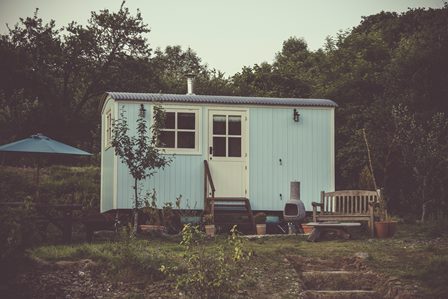
If you haven’t heard the term “Tiny House” you can correctly assume that it describes a very small house, but there is a movement now to build and live in tiny houses by people who don’t necessarily need to. Many just want to live in a tiny house, for environmental reasons and even for spiritual reasons, to live without so many material trappings.
In a web search for Tiny Houses you will see some houses that look like little Hobbit cottages, mini-mansions, wood sheds, and just about any architectural style in miniature form. Some Tiny Houses are built on the ground while others are on wheels and appear to be no more than glorified campers.
With global economic concerns, the Tiny House now also seems like the next solution to those who really won’t be able to afford larger spaces, along with the utility bills. The definition of a Tiny House is somewhat loose because the dimensions can be from less than 100 square feet to over 800 square feet. Many people would not consider 800 square feet to be a Tiny House as many apartments and even some conventional houses are that size. But I think the distinction may have to do with how many occupants live there.
I used to say in my Feng Shui classes that every person deserves a least 600 square feet of their own. I was not being literal. However, questions often arise regarding whether a house can be too small or too large according to Yin-Yang Theory. Some of the criteria for judging whether a home has good Feng Shui has to do with qi flow. Whether a house is large or small, if it is cluttered or overly filled with furnishings, there may not be enough open space for proper qi flow (air currents). When a house’s energy is stifled from lack of space, the occupant’s health can be undermined.
I’ve seen small spaces that were neat as can be and I have also seen palatial homes that were terribly cluttered.
With Feng Shui theory and applications, we are trying to achieve a balance of size in relation to the number of occupants, but it also matters how they furnish that living space, and even to a certain extent how much entertaining they do or if they have pets.
Another design dilemma with the Tiny House is the forced need to use certain areas for multiple purposes. Some Tiny House floor plans have bunk style beds over a living room or over a kitchenette. Like a Studio apartment, both yin and yang activities take place in the same room. This isn’t the end of the world, but normally we don’t want people to have to sleep in the same room where they conduct business.
So many people now have home offices, but to put this all in 100 square feet can be a conflict of interest. In Xuan Kong Feng Shui we also interpret the energies differently and prescribe different adjustments, based sometimes on how the space is used. This can be a little more challenging when the same room is used for sleeping, eating, studying or business, along with personal relations.
Like an ashram community or any communal living, I think a happy medium for the Tiny House is to be in a Tiny House community, where a group of Tiny House owners can also share some common areas. It also helps if the Tiny House is placed on a good sized piece of land, where a person can enjoy the outdoors and not end up feeling like they are in a kind of prison cell.
Author: Kartar Diamond
Company: Feng Shui Solutions ®
From the Architecture & Design Blog Series
